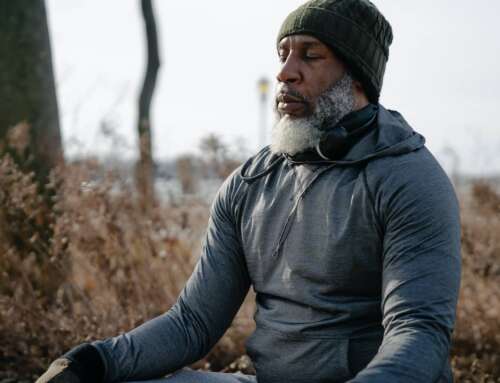Most sex coaches are familiar with the stress response cycle, as well as the relationship between stress and sexual desire. It’s biological: the higher the stress, the less safe your body feels, thus the lower the desire to have sex. We talk to our clients about burnout, but talking about stress within our professional practice as a result of working with clients remains a taboo conversation among sex coaching colleagues. How can we learn to manage practitioner burnout?
Many coaches within the Sex Coach U community feel called to do this work because they naturally want to help people. They have a desire to spread sex positivity within their communities. Some already function as secret-keepers and advice-givers among friends, before ever receiving their certification.
So why do some students have such a hard time maintaining their coursework? Why do sexologists struggle with taking on negative emotions within their sessions with certain clients? Shouldn’t professionals with so much practice holding space for others have enough experience to never get tired!?
Of course not! The more passionate you are about a career, the harder it is to say no to work, and the stronger the need is to set boundaries within your practice. Many coaches are also empaths. This makes them naturally better listeners and, in turn, more responsive coaches. However, when work bleeds into one’s personal life, it often interferes, making it harder for practitioners to strike a balance.
“No wonder helping professionals are so exhausted, you’re confronted with people in need all day, day after day.” – Burnout by Emily and Emelia Nagowski
One good place to start creating balance to manage practitioner burnout is recognizing your own signs of stress. For prehistoric humans, stress was a bodily reaction to acute, physical threats, such as the presence of a predator on the savannah, the threat of starvation, disease, etc. Faced with these life-or-death situations, stress is actually quite helpful because it motivates us to take action to resolve or avoid those threats.
In contrast, our modern society operates on a knowledge economy, which takes the emphasis off of physical work and places it onto psychological labor. Most of the stressful situations we face today are mental, emotional, and sometimes chronic.
There are four main types of stress responses. Familiarizing yourself with what they are and which one(s) tend to manifest for you enables you to recognize symptoms, set appropriate boundaries, and know when you’re close to burning out.
Fight or Flight: An Indication of Practitioner Burnout
The most well-known stress responses are fight and flight. These feel physically similar since both stimulate the sympathetic nervous system. When this occurs, our circulatory system kicks in, increasing heart rate, breathing, and blood flow. Your muscles might tremble and your skin may either flush or pale depending on how blood moves through your organism.
Let’s compare fight and flight, in response to the physical threat of a tiger versus that of a busy work schedule.
Fight is the instinct to attack the tiger, while flight is the desire to flee. A fight responder may “attack” their workload by overachieving. Or they may respond aggressively toward attempts to help and accidentally misdirect their fight response toward friends or family.
On the other hand, flight manifests as anxiety, worry, and perfectionism. When faced with a long to-do list, flight-types tend to overthink every scenario and pursue none of them, procrastinating on their responsibilities. Both fight and flight can have serious consequences, especially in a professional environment.
Freeze: A Manifestation of Practitioner Burnout
Most folks will start at either fight or flight. When one doesn’t work, they try the other. However, if neither response is successful in relieving stress, our dorsal vagal system turns on and we freeze. For some people, freeze is their initial or default response to stress.
In this reaction state, endorphins numb nerves and raise the pain threshold. The bodily systems that increase in fight or flight, like heart rate and blood pressure, decrease. The metabolism slows, allowing the body to begin conserving energy. Freeze is an emergency state, in which you try hiding from the tiger by camouflaging, or playing dead.
This response causes dissociation and withdrawal. In freeze, you avoid socializing and you may experience indecision, depression, helplessness, etc. If you can’t get out of bed or accomplish daily tasks, please seek the help of a mental health professional.
Freeze is most common as a trauma response exhibited in victims of PTSD. In more mild cases, freeze can also manifest as burnout or exhaustion. If you are feeling overworked, emotionally drained, or find yourself zoning out, especially during formerly enjoyable activities, you may be enacting the freeze stress response.
Fawn

Photo by Brett Sayles from Pexels
One less commonly discussed stress response is fawn, which involves trying to appease another person to avoid conflict. Fawn is the hardest to identify because many psychologists view it as a personality trait. This is because fawning is most frequently learned in childhood, especially when a parent or authority figure is an abuser.
In the context of our previously mentioned physical threat (the tiger), fawning would be trying to convince the tiger not to eat you, which isn’t highly practical. Fawning has evolved as a recent adaptation to modern-day stressors. Some reframe this response as “mate or fornicate.” What is often missed in the shorthand “fight or flight” is that on a psychological level, the difference between good excitement and bad distress is a matter of perception, or how you interpret the stimulus event. Adrenaline gets released during both. So while sexual arousal begins as a function of the relaxation response, when it ends with orgasm, the sympathetic nervous system is involved.
Take an unpleasant conversation about politics, for example. A fawner wouldn’t speak up or change the topic, but would instead engage with the other person at a shallow, surface level, so the individual can’t tell that the topic causes stress. They preemptively agree, saying whatever they think the other party wants to hear, and they ignore their own feelings.
Over time, this fawn response becomes a codependent pattern. At this point, it becomes hard to recognize within yourself! A clue might be that you look to others for cues on how to feel in a situation, or it may feel difficult for you to identify personal beliefs. Do you prioritize the needs of others at the expense of your own? Do others call you a doormat because you have trouble saying no?
So, what do you do if you recognize these signs within yourself? Here are a few practical and accessible suggestions for taking care of yourself when you’re stressed out to manage practitioner burnout.
Saying NO
Not everyone is going to be the right client for you, and you’re not the coach for everyone. Sometimes, the best thing you can do for yourself and the client is encourage them to work with someone else.
The right person will be drawn to your vibe, your personality, your services, and your way of doing things. That is why there is room for all of us in this industry! No one else can share this information the way that you can.
So don’t be afraid to reject a client, if it’s not the right fit, and refer out. We all know these words of wisdom—practice them often.
You cannot be everything to everyone, or the client will start to believe their healing comes from you rather than from within themselves. Everyone needs a team of guides, coaches, and mentors.
Connection and Community
When the going gets tough, it’s okay to ask for help! Lean on your colleagues. The SCU community exists to help you work within a team. A client isn’t any “less yours” if you ask for others’ input. Friends and family can also be a source of support. It can be a great way to manage or prevent practitioner burnout.
The Gottman Institute proved that a kiss as short as six seconds or a 20-second hug can help you feel connected, and both will boost your oxytocin, dopamine, and serotonin levels. These feel-good brain chemicals all help reduce stress. Can you guess what else releases these chemicals? Orgasm! Rock your feelings out the sex coach way!
Manage Practitioner Burnout with Breath
This is the most basic but useful tool we naturally have in response to stressful emotions. You may not be able to immediately hug a friend or say an affirmation in a public setting, but you can absolutely soothe yourself by learning proper breath techniques.
You might remember that during some stress responses, your breath naturally gets shallower. So working to even your breathing to baseline will physically reduce cortisol levels to bring down your stress.
A good way to do this is to exercise “box-breathing.” Breathe in for four counts, and while you do, picture drawing a horizontal line in your mind. Breathe out for four counts, and make a right angle with the same line. Repeat for another eight counts, until you’ve imagined an even square drawn in front of you, made up of each breath in and out.
For more interesting breathing techniques, such as alternate nostril breathing, look to yogic pranayama techniques.
While the stressors in our modern-day coaching practices are more complex than those of our prehistoric predecessors, we have a number of tools to prevent practitioner burnout and deal with stress as it surfaces. Something as simple as your morning shower can be turned into a coping mechanism with a little mindfulness. You can blast your favorite rock ballads and sing along, or soak your cares away with an herbal scrub as you take in every scent and sensation.
Bring awareness to your habits, learn to say no and protect your boundaries, recognize your symptoms, focus on your breath, and reach out for support. All of these tools will help you advocate for and protect your mental health so that you can bring your best self to your self coaching practice.
Curious about training to become a Certified Sex Coach™? Join the next live Info Session to meet the SCU team and participate in a live Q&A!







